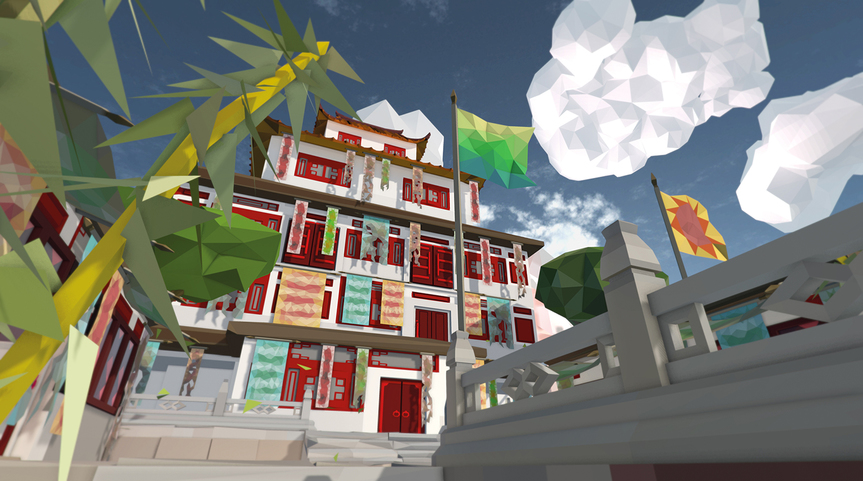
R
E
V N
E
X
T
The dimly lit hotel lobby—a room filled with dark, heavy wood, with detailed parquet floors and ceiling—materialized like the backdrop out of a film noir. Several black-and-white photographs, along with worn-looking textiles, hang on the walls, which are covered with an ornate, jade-green fabric. The looping soundtrack of a 1930s jazz piano hinted that I had traveled back in time. I saw no other guests, only the translucent figures of ghosts scattered about—some of them alone, others conversing with each other. Those apparitions were my first clue that the old Himalayan Hotel I had landed in was not so much a faithful reproduction as it was an imagined history.
Still from SHEZAD DAWOOD’s Kalimpong, 2016, virtual reality. Courtesy Timothy Taylor Gallery, London/New York.
Kalimpong (2016) by London-based artist Shezad Dawood makes its stateside debut at New York City’s Rubin Museum of Art. Many of the Himalayan artifacts housed in the museum’s collection served as references for the virtual reality. The work appeared as part of “A Lost Future,” a multi-part exhibition that aimed to cast a contemporary light upon the artistic traditions of a region spanning from Pakistan to India, Nepal and China. The mountain town of Kalimpong historically represented a crossroads in the Himalayas, where Buddhists pilgrims co-mingled with Yeti hunters and political operatives. India’s former prime minister Jawaharlal Nehru famously described the place as a “nest of spies.” The mysterious nature of the location easily lends itself to mythologizing and, in the case of Dawood’s art, to a digital fantasy.
In revisiting the past, Dawood strives to square the traditional with the technological—VR serving as a space where both can coexist. Among the many duplications of actual Buddhist paintings and Tibetan textiles in Kalimpong, Dawood includes facsimiles of his contemporary artwork, including a bust of early 20th-century French explorer Alexandra David-Néel. A childhood idol of Dawood’s whom he describes as a “strong, female Indiana Jones,” David-Néel most notably wrote about sneaking into Lhasa in 1924 when Tibet remained closed to foreigners. In addition to the digital rendering, the artist pays homage to this forgotten icon with a physical sculpture, which sat in the gallery just outside the VR room. A bronze painted in white and dusted with an icy shimmer, Kalimpong (Alexandra David-Néel) (2016) expresses a simultaneity of time by depicting the individual at three different instances—what Dawood terms as a “quantum portrait.” He gives the same treatment to Ekai Kawaguchi, a Japanese Buddhist monk who was the first from his country to journey into Tibet, and who is credited for introducing David-Néel to the 13th Dalai Lama. Kalimpong (Ekai Kawaguchi) (2016) likewise exists both in the virtual world and in the gallery.
Dawood weaves hazy facts with compelling fiction into the loose narrative of Kalimpong. For instance, the encounter with a sorcerer-monk in a hermitage cavern—a scene which awaits visitors after venturing out of the hotel—draws directly from David-Néel’s accounts of her travels across Tibet. Meanwhile, the stretch of snow-covered mountain that connects the hotel and the cave felt similarly dreamlike. I paused to watch cotton-ball-sized white flakes fall from the black sky, where polygonal clouds floated. On-screen glitches and the foreboding rumble of an avalanche signaled the approach of the elusive Yeti, who lumbered past like a gorilla walking upright. Not unlike the obviously computer-generated clouds, the glitches emphasized the unreality of the moment.
Dawood’s juxtaposition of realism with abstraction can also be observed in his rendering of Nepal’s Pangboche Monastery, which features an almost photographic sunset behind a deliberately geometric landscape. Inside, the monastery displays two purported Yeti relics—a scalp and bones from its hand—as well as a photograph of Old Hollywood actor Jimmy Stewart, who supposedly helped smuggle a stolen piece of finger bone from Nepal for testing in the United States in the1960s. Dawood’s fascination with the lore that surrounds the region coalesces with a spiritual purpose in the final act of Kalimpong, where “touching” a book initiates the ending sequence. It’s here that the constructed reality, much like the physical world I seemed to long ago have left behind, finally falls away. As the room around me disappeared, I was left hovering in what appeared to be a cosmic space, or some higher plane of existence.
The separation between mind and body, the blurring of the line between the physical and metaphysical, all find a natural home in the VR, which ultimately manifests as an existential journey for each individual. Although an in-person museum guide was on hand to lead the virtual tour, participants were encouraged to explore on their own and linger in each scene. A hand-held controller allowed for an interactive experience, in which users could virtually pick up books, climb stairs and unlock secret passageways. Dawood explained that he used the Buddhist concept of the bardo—the liminal stages between life and rebirth—as the “secret structure” for his storytelling. “There’s always a degree of meticulous obsession in the way that things connect,” he said about his work. Regardless of whether I fully grasped the intricate narratives or the symbolic meanings contained therein, I appreciated Kalimpong’s richly realized form. More than anything, I found a strange beauty in the artist’s lifelong fixation with this singular setting and its hidden stories.
Mimi Wong is a New York desk editor of ArtAsiaPacific.
“A Lost Future: Shezad Dawood” is on view at the Rubin Museum of Art, New York, until May 21, 2018.
To read more of ArtAsiaPacific’s articles, visit our Digital Library.





